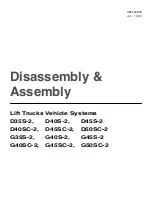
OPERATING PROCEDURES
NARROW AISLE
22
up and down. The center of gravity, and therefore the
stability of the loaded lift truck is affected by a number of
factors, such as size, weight, shape, and position of the
load; the height to which the load is raised; the amount of
forward or backward tilt and the dynamic forces created
when the truck is moving.
Combined CG
CG Truck
CG Load
These dynamic forces are caused by things like
acceleration, braking, turning, and operating on uneven
surfaces or on an incline. These factors must be considered
when traveling with an unloaded truck, as well, because
an
unloaded truck will tip over to the side easier
than a
loaded truck with its load in the lowered position.
In order for the lift truck to be stable (not tip over forward or
to the side) the CG must stay within the area of the lift truck
represented by a triangle drawn between the load wheels
and the pivot of the steering axle.
CG--Truck Will Tip Over
Load Wheel Axle
Steering Axle Pivot
If the CG moves forward of the load wheels, the lift truck will
tip forward. If the CG moves outside of the line represented
by the lines drawn between the load wheels and the
steering axle pivot, the lift truck will tip to that side.
Stability and traction will also be affected if the drive unit
articulation stops are not adjusted properly. The articulation
stop screws must be adjusted to the proper setting as listed
on the nameplate and in the Articulation Chart found in the
Maintenance Section.
Property of American Airlines
































